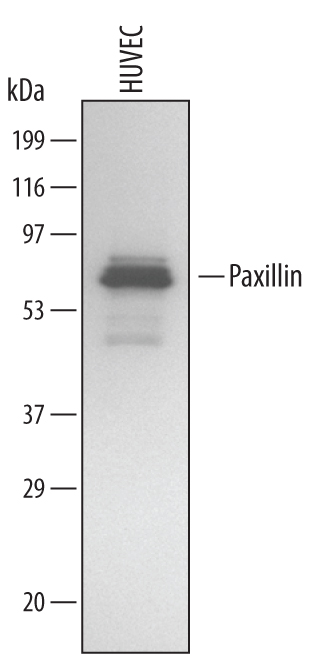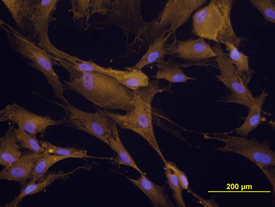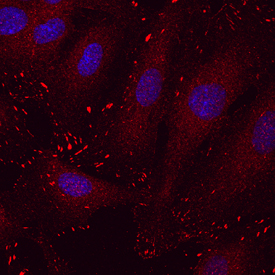Human Paxillin Antibody Summary
Asn59-Ser274
Accession # P49023
Applications
Please Note: Optimal dilutions should be determined by each laboratory for each application. General Protocols are available in the Technical Information section on our website.
Scientific Data
 View Larger
View Larger
Detection of Human Paxillin by Western Blot. Western blot shows lysates of HUVEC human umbilical vein endothelial cells. PVDF membrane was probed with 1 µg/mL of Mouse Anti-Human Paxillin Monoclonal Antibody (Catalog # MAB4259) followed by HRP-conjugated Anti-Mouse IgG Secondary Antibody (Catalog # HAF007). A specific diffuse band was detected for Paxillin at approximately 65 to 70 kDa (as indicated). This experiment was conducted under reducing conditions and using Immunoblot Buffer Group 3.
 View Larger
View Larger
Paxillin in Detroit 551 Human Cell Line. Paxillin was detected in immersion fixed Detroit 551 human embryonic skin fibroblast cell line using Mouse Anti-Human Paxillin Monoclonal Antibody (Catalog # MAB4259) at 10 µg/mL for 3 hours at room temperature. Cells were stained using the NorthernLights™ 557-conjugated Anti-Mouse IgG Secondary Antibody (yellow; Catalog # NL007) and counter-stained with DAPI (blue). View our protocol for Fluorescent ICC Staining of Cells on Coverslips.
 View Larger
View Larger
Paxillin in HUVEC Human Cells. Paxillin was detected in immersion fixed HUVEC human umbilical vein endothelial cells using Mouse Anti-Human Paxillin Monoclonal Antibody (Catalog # MAB4259) at 10 µg/mL for 3 hours at room temperature. Cells were stained using the NorthernLights™ 557-conjugated Anti-Mouse IgG Secondary Antibody (red; Catalog # NL007) and counterstained with DAPI (blue). Specific staining was localized to actin filament tips. View our protocol for Fluorescent ICC Staining of Cells on Coverslips.
Reconstitution Calculator
Preparation and Storage
- 12 months from date of receipt, -20 to -70 °C as supplied.
- 1 month, 2 to 8 °C under sterile conditions after reconstitution.
- 6 months, -20 to -70 °C under sterile conditions after reconstitution.
Background: Paxillin
The cytoskeletal adaptor protein Paxillin is found at the interface between actin filaments and the plasma membrane. Paxillin localizes to focal adhesions, where it provides a platform for the integration and coordination of adhesion- and growth factor-related signals. Paxillin phosphorylation is required for integrin-mediated cytoskeletal reorganization, and may play a role in the disassembly of focal adhesions and stress fibers during cellular transformation. Increased Paxillin protein levels have also been reported in several malignancies, including renal, lung, and breast carcinomas.
Product Datasheets
Citation for Human Paxillin Antibody
R&D Systems personnel manually curate a database that contains references using R&D Systems products. The data collected includes not only links to publications in PubMed, but also provides information about sample types, species, and experimental conditions.
1 Citation: Showing 1 - 1
-
Identification of lymphocyte cell-specific protein-tyrosine kinase (LCK) as a driver for invasion and migration of oral cancer by tumor heterogeneity exploitation
Authors: J Wei beta e, J Rosemann, L Müller, M Kappler, AW Eckert, M Gla beta, D Misiak, S Hüttelmaie, WG Ballhausen, M Hatzfeld, M Haemmerle, T Gutschner
Molecular Cancer, 2021-06-11;20(1):88.
Species: Human
Sample Types: Cell Lysates
Applications: Western Blot
FAQs
No product specific FAQs exist for this product, however you may
View all Antibody FAQsReviews for Human Paxillin Antibody
There are currently no reviews for this product. Be the first to review Human Paxillin Antibody and earn rewards!
Have you used Human Paxillin Antibody?
Submit a review and receive an Amazon gift card.
$25/€18/£15/$25CAN/¥75 Yuan/¥2500 Yen for a review with an image
$10/€7/£6/$10 CAD/¥70 Yuan/¥1110 Yen for a review without an image



